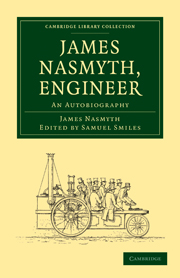Book contents
- Frontmatter
- PREFACE
- Contents
- ILLUSTRATIONS
- CHAPTER I MY ANCESTRY
- CHAPTER II ALEXANDER NASMYTH
- CHAPTER III AN ARTIST'S FAMILY
- CHAPTER IV MY EARLY YEARS
- CHAPTER V MY SCHOOL-DAYS
- CHAPTER VI MECHANICAL BEGINNINGS
- CHAPTER VII HENRY MAUDSLEY, LONDON
- CHAPTER VIII MAUDSLEY'S PRIVATE ASSISTANT
- CHAPTER IX HOLIDAY IN THE MANUFACTURING DISTRICTS
- CHAPTER X BEGIN BUSINESS AT MANCHESTER
- CHAPTER XI BRIDGEWATER FOUNDRY—PARTNERSHIP
- CHAPTER XII FREE TRADE IN ABILITY—THE STRIKE—DEATH OF MY FATHER
- CHAPTER XIII MY MARRIAGE—THE STEAM HAMMER
- CHAPTER XIV TRAVELS IN FRANCE AND ITALY
- CHAPTER XV STEAM HAMMER PILE DRIVER
- CHAPTER XVI NUREMBERG—ST. PETERSBURG—DANNEMORA
- CHAPTER XVII MORE ABOUT BRIDGEWATER FOUNDRY—WOOLWICH ARSENAL
- CHAPTER XVIII ASTRONOMICAL PURSUITS
- CHAPTER XIX MORE ABOUT ASTRONOMY
- CHAPTER XX RETIREMENT FROM BUSINESS
- CHAPTER XXI ACTIVE LEISURE
- CHRONOLOGICAL LIST OF INVENTIONS AND CONTRIVANCES
- SUN-RAY ORIGIN OF THE PYRAMIDS, AND CUNEIFORM CHARACTER
- INDEX
- Plate section
CHAPTER XVII - MORE ABOUT BRIDGEWATER FOUNDRY—WOOLWICH ARSENAL
Published online by Cambridge University Press: 10 November 2010
- Frontmatter
- PREFACE
- Contents
- ILLUSTRATIONS
- CHAPTER I MY ANCESTRY
- CHAPTER II ALEXANDER NASMYTH
- CHAPTER III AN ARTIST'S FAMILY
- CHAPTER IV MY EARLY YEARS
- CHAPTER V MY SCHOOL-DAYS
- CHAPTER VI MECHANICAL BEGINNINGS
- CHAPTER VII HENRY MAUDSLEY, LONDON
- CHAPTER VIII MAUDSLEY'S PRIVATE ASSISTANT
- CHAPTER IX HOLIDAY IN THE MANUFACTURING DISTRICTS
- CHAPTER X BEGIN BUSINESS AT MANCHESTER
- CHAPTER XI BRIDGEWATER FOUNDRY—PARTNERSHIP
- CHAPTER XII FREE TRADE IN ABILITY—THE STRIKE—DEATH OF MY FATHER
- CHAPTER XIII MY MARRIAGE—THE STEAM HAMMER
- CHAPTER XIV TRAVELS IN FRANCE AND ITALY
- CHAPTER XV STEAM HAMMER PILE DRIVER
- CHAPTER XVI NUREMBERG—ST. PETERSBURG—DANNEMORA
- CHAPTER XVII MORE ABOUT BRIDGEWATER FOUNDRY—WOOLWICH ARSENAL
- CHAPTER XVIII ASTRONOMICAL PURSUITS
- CHAPTER XIX MORE ABOUT ASTRONOMY
- CHAPTER XX RETIREMENT FROM BUSINESS
- CHAPTER XXI ACTIVE LEISURE
- CHRONOLOGICAL LIST OF INVENTIONS AND CONTRIVANCES
- SUN-RAY ORIGIN OF THE PYRAMIDS, AND CUNEIFORM CHARACTER
- INDEX
- Plate section
Summary
The rapid extension of railways and steam navigation, both at home and abroad, occasioned a largely increased demand for machinery of all kinds. Our order-book was always full; and every mechanical workshop felt the impulse of expanding trade. There was an increased demand for skilled mechanical labour—a demand that was far in excess of the supply. Employers began to outbid each other, and wages rapidly rose. At the same time the disposition to steady exertion on the part of the workmen began to decline.
This state of affairs had its usual effect. It increased the demand for self-acting tools, by which the employers might increase the productiveness of their factories without having resort to the costly and untrustworthy method of meeting the demand by increasing the number of their workmen. Machine tools were found to be of much greater advantage. They displaced hand-dexterity, and muscular force. They were unfailing in their action. They could not possibly go wrong in planing and turning, because they were regulated by perfect modelling and arrangements of parts. They were always ready for work, and never required a Saint Monday.
As the Bridgewater Foundry had been so fortunate as to earn for itself a considerable reputation for mechanical contrivances, the workshops were always busy.
- Type
- Chapter
- Information
- James Nasmyth, EngineerAn Autobiography, pp. 307 - 322Publisher: Cambridge University PressPrint publication year: 2010First published in: 1883



